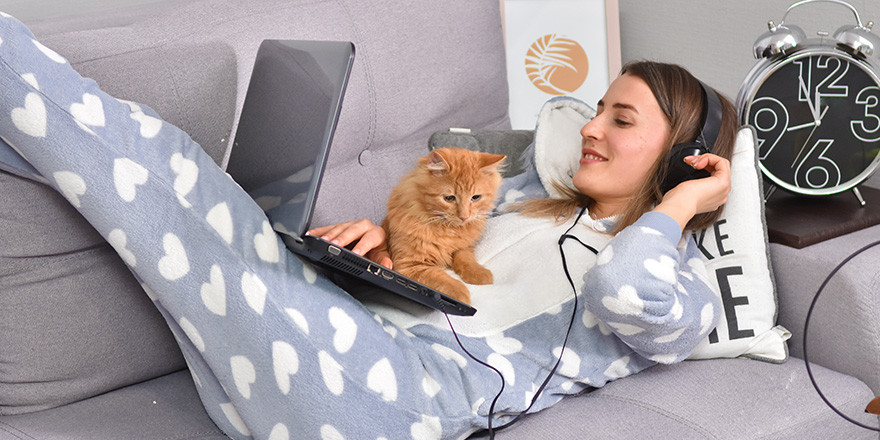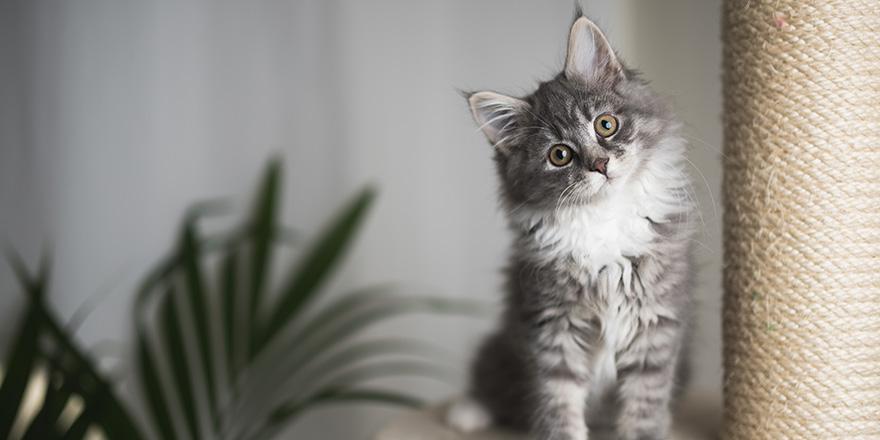New cat owners aren’t often in the habit of checking the adult size and weight averages of the kitten they’ve brought home. With adult cats, you’ve already got a good guideline because they don’t typically grow much bigger unless they put on weight from overeating and lack of exercise. This leads a lot of cat owners to wonder how big their cats will get over their lifetime, so we’re here to help answer that question.
Key Takeaway Points:
- The average mixed breed cat will weigh anywhere from 8 to 12 pounds, with a height up to 10 inches.
- The biggest cat breed are the world is Maine Coon cats.
- It’s common for the “runt” of the litter to remain small, even when they reach their adult size.
- Some cats are naturally smaller than others of the same breed.
- Neutering your cat may make them gain weight, but it won’t be the only reason they’ve gained weight.

How Big Will My Cat Get?
The size of your cat will depend on several factors, but each breed does have its own average height, length, and weight measurements available. Male cats are often slightly bigger than female cats, even in large cat breeds like Persian cats and Norwegian Forest cats.
For the American domestic shorthair, which is one of the most common cat breeds in the USA, these are the measurements that you can expect:
- Height – 8 to 10 inches
- Length – 12 to 15 inches
- Weight – 10 to 15 pounds
When considering the size of your cat, you should always explore the statistics of that cat’s breed. It’s possible for your cat to weigh more or less than the average of their breed, especially if they eat a lot of adult food without exercising much. However, the average size statistics are always a good place to start if you find yourself looking at your cat and pondering “how big will my cat get?”.
Do Indoor Cats Get Bigger than Outdoor Cats?
Because they exercise less and have less space to run around and play in, most indoor cats will become heavier than outdoor cats. That’s not to say that an outdoor cat won’t find its way to other families and start overeating, though!
This is a huge problem with being the owner of an outdoor cat because people feed cats whether they have a collar on or not. If a human thinks a cat “looks hungry” or they’ve seen them a few days in a row, they almost can’t be stopped from buying that cat food or finding a tin of tuna to put out for it.
When Does a Cat Stop Growing?
Common domestic cat breeds usually stop growing anywhere from 12 to 16 months old. At least, they stop growing in height and length. It’s always possible for a cat to gain or lose weight – though it’s much easier for cats eating too much adult cat food to gain weight.
Larger cat breeds like Ragdoll cats and Maine Coons will continue growing until they’re around 5 years old. If your cat hasn’t grown anymore after they’ve reached the age of two, you can consider that they have finished growing and their current size is where they’ll be for the rest of their time.
Kittens tend to grow very quickly, almost as if you’ve blinked and missed an entire part of their growth. Next time you welcome a kitten in to your home, why not have some fun by documenting how quickly they grow? A photo a week is a good measurement.
Kitten food is high in fat and protein because baby cats use a lot of energy, so this helps them grow a bit faster, too. That’s also why it’s said that you shouldn’t give kittens adult cat products until they’re older because these food products don’t have the right nutrients that a growing cat needs.
How to Tell if a Cat Is Overweight
It’s pretty easy to tell when a breed like an American Shorthair is overweight, even without taking them to your vet and having them weighed by a professional. Shorthaired cats have nowhere to hide their weight, so you’ll see that their body has widened and that their stomach pouch is lower than the floor because they’ve gotten bigger.
That said, do not take the size or positioning of your cat’s stomach pouch as an indication that they’re overweight. This pouch is called a primordial pouch and it’s perfectly normal for your cat to have one. It’s a protective layer positioned along your cat’s belly, and it helps stop their important organs from getting hurt. At least, that’s one theory.
Another is that the extra skin allows cats to stretch further in the wild, and domestic cats haven’t evolved out of having one. Most cats have them, some are just more prominent than others.
The best way to tell if your cat is actually overweight is to weigh them. You can even do this at home by weighing yourself, then weighing yourself holding your cat, and doing the math. Cats are also weighed at each yearly check-in with their veterinary practice.
Caring for Your Cat No Matter Their Size
Before you adopt or purchase a new kitty, always do a little research into their breed so that you can be prepared for the size they’ll be when they’re older. If you’re a new cat owner, you may not want to start out by adopting a cat as big as a Maine Coon. They can grow very large, and it can be overwhelming for new cat parents. Big breed cats reach huge weights and sizes; they’ll need room to play so that they don’t gain unnecessary weight.
How to Put Your Cat On a Diet
If your vet has advised you that your cat is overweight and needs to lose a couple of pounds, they’ll need to go on a diet. Putting your cat on a diet doesn’t mean that you need to restrict their food intake, though this is one method that can work.
First, look at the type of food your cat is eating. Indoor cats don’t need as many calories as outdoor cats, so if you’ve got your domestic kitty on standard cat food, they may be gaining weight from overeating.
Most domestic cats that are kept indoors become very inactive, especially if they have busy owners or are pets to individuals who aren’t in good health. If you cannot play with your cats every day, stock your home with plenty of cat toys that will stimulate your cat. You should also have multiple scratching and climbing areas. You may also be interested in our guide on cat food for weight loss.
Remember – proper nutrition, exercise, quality cat toys. These are the steps to success when helping your cat avoid weight gain. You may also want to invest in a cat exercise wheel.
What are the Biggest Cat Breeds?
Below, you’ll find a list of five of the larger breeds of cat in the world, as well as their average height and weight:
| Breed | Height | Weight |
|---|---|---|
| Siberian cat | 10 to 12 inches | 10 to 15 inches |
| Ragamuffin | 10 to 15 inches | 10 to 20 pounds |
| Ragdoll | 9 to 11 inches | 10 to 20 pounds |
| Turkish Van | 10 to 14 inches | 10 to 20 pounds |
| Maine Coon | 9 to 10 inches | 8 to 25 pounds |

What Determines How Big a Cat Gets?
Cats grow at different rates, depending on their breed, the size of the litter they were born into, and lots of other factors. When trying to figure out how big your cat will grow, the size of their legs as a kitten is one way to tell if you’ll have a big fur baby. Tall back legs are an indicator of a big cat. Your kitten’s growth will tell you a lot about the kind of cat they’ll grow up to be.
At five months old, your kitten will weigh around half the amount they should be when they’ve finished growing up as a healthy cat. Not all cats from the same litter will grow to the same size, particularly if they were the mother cat’s first litter or one of the kittens was a runt.
Cats continue to grow until they’re an average of a year to a year and a half old. At this state, most cats’ growth will stop unless they’re gaining weight or belong to a larger cat breed.
The size of a kitten’s paws has no indication of their size later in the cat’s life. Enjoy the kitten stage while it lasts, they won’t be small forever.
FAQs:
Some cats stay small because of genetic reasons, others are small because of environmental factors (such as not getting enough food from a young age). If your vet tells you that your cat is healthy, you may just be the proud owner of a smaller-than-average cat. This usually means that your cat is smaller in size than other domestic cats of the same breed, and may seem to stop growing after a few months. They stay the size of an older kitten.
Neutering your cat, whether they're male or female, does typically mean that they are going to gain some weight. Some cats end up overweight after being neutered, but it's not just the castration that causes them to gain weight. Neutering a cat just means that they aren't expending the energy they were originally using after they reached sexual maturity. They become calmer, and usually lazier. To combat this, keep your cat active.







